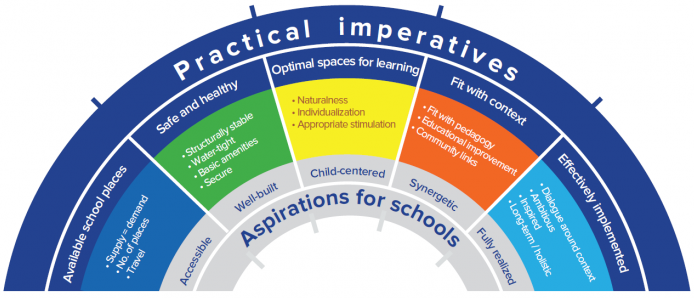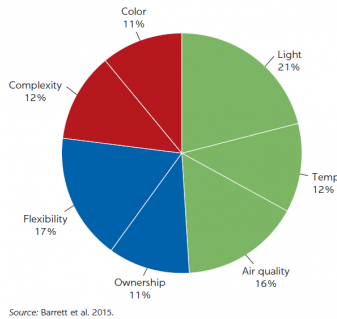One of the ways to ensure education quality in schools is to create education facilities that are child-centred and provide a safe, inclusive, and effective learning environment for all. In this post, Shmis, Ambasz, Ustinova, and Vivek review the research on learning environments and discuss how school facilities can affect children’s learning outcomes.
From a very early age, today’s children are spending more and more time in nurseries, kindergartens, or schools. According to international statistics, educational service coverage is increasing worldwide. In 2015, 49 percent of children attended pre-school institutions, more than 89 percent attended primary schools, and 65 percent had full access to general education (primary and secondary). According to the Organisation for Economic Co-operation and Development (OECD), by age 15, students have, on average, spent 7,538 hours on school premises (OECD, 2017). Thus, the school environment ranks second, after the home environment, as the place where students spend the majority of their time. It also can become a ‘third teacher’ (after the family and the educator) if it is arranged to support learning. The term ‘third teacher’ was first used by Italian pedagogue, Loris Malaguzzi, who went on to explain that the learning environment represented not only a tool for educators, but also an independent source of discoveries and experiences for students (Cagliari et al. 2016).
One of the ways to harness the school environment as a ‘third teacher’ is to create education facilities that are child-centred and provide a safe, inclusive, and effective learning environment for all.
How is this achieved in practice? Building a school requires knowledge about teaching approaches, construction technologies, site parameters, and user needs as well as the strong involvement of different stakeholders (for example, project managers, school principals and teachers, architects, politicians, and community members). For those who develop and implement national policies on school network expansion as well as for those who work on education facilities project implementation in the field, the availability of good-quality research on these topics is crucially important for taking informed decisions.
In our new book, The Impact of School Infrastructure on Learning: A Synthesis of the Evidence, the first three authors of this blog review the current research on learning environments and examine how school facilities can affect children’s learning outcomes. We identify key parameters for guiding the design, implementation, and supervision of educational infrastructure projects. We also reflect on where the existing evidence could be strengthened, and identify areas for further exploratory work.
Our review identifies the following aspects of school settings as having a significant impact on children’s academic outcomes: school size, access to school and time spent traveling to school, class size, schedule and length of the study day, optimal use of learning environments, and availability of schools for children with special educational needs (see Figure 1).
Figure 1. Learning environments for better educational outcomes
The engineering aspects of school buildings also contribute to the overall quality of the learning environment; for example, natural light, temperature, and air quality are significant contributors to users’ perceptions of the space and their ability to function. One of the most influential studies on this topic – ‘Clever Classrooms’ by Professor Peter Barrett and colleagues – claims that the learning environment explains 16% of the difference in achievement, and that half of the improvement in learning outcomes is related to hard infrastructure solutions (quality of air, lightning, and temperature) (Figure 2).
Figure 2. Contribution of each classroom measure
The more successful school designs occur when building users and stakeholders plan and develop the design in harmony with their cultural, pedagogical, and economic contexts. Sometimes schools or preschools become part of community centres, where, for example, sports facilities can be used by neighbours, while students may use the public library.
New learning approaches require different learning environments. For instance, the education community in Finland is actively discussing a new curriculum reform called ‘phenomena-based lessons’ whereby subjects are integrated into multidisciplinary research activities. This means that the class is no longer characterized as a gathering of a certain number of students for a 40-minute lesson, but rather involves the parallel work of diverse groups of students and teachers on a given topic. For example, two small groups may combine to work with two teachers while at the same time one larger group may work with one teacher. Experimentation, collaboration, and creativity are becoming very important for teachers in such settings.
Different approaches to design help make buildings more economical while at the same time making them more multifunctional. Whereas the traditional school design allocates 10 to 25% of space to corridors, alternative approaches such as central space design allow for more diverse use of this space while at the same time reducing the school footprint by 10 to 15%. It is important to mention though that ‘fit for purpose’ is the most important criterion for learning environment design and teaching and learning practices should be the leading consideration in the arrangement of learning environments.
India is also increasingly recognising the relevance of physical spaces for learning. The 2005 National Curriculum Framework (NCF) stresses the need to derive maximum educational value from schools’ physical assets and underscores the potential gains that can be accrued by connecting physical spaces to pedagogical approaches and the child. Over the last decade, states such as Delhi, Gujarat, Himachal Pradesh, and Odisha have experimented with concepts such as Building as Learning Aid (BaLA), but much more could be done in this area. As further analysis and evidence on the relationship between learning environments and learning outcomes emerges, Indian stakeholders need to ensure that these ideas are used to inform public investments in school infrastructure upgradation across India.
An earlier version of this post appeared in World Bank Blogs: https://blogs.worldbank.org/education/learning-environment-third-teacher-evidence-impact-school-infrastructure
Further Reading
- Barrett, P, Y Zhang, F Davies and L Barrett (2015), ‘Clever Classrooms: Summary Report of the HEAD Project’, University of Salford, Salford.
- Cagliari, P, M Castagnetti, C Giudici, C Rinaldi, V Vecchi and P Moss (eds.) (2016), Loris Malaguzzi and the Schools of Reggio Emilia, Routledge, London.
- OECD (2017), ‘Table D1.1. Instruction time in compulsory general education1 (2017)’, in Education at a Glance 2017: OECD Indicators, OECD Publishing.




 06 December, 2019
06 December, 2019 









Comments will be held for moderation. Your contact information will not be made public.